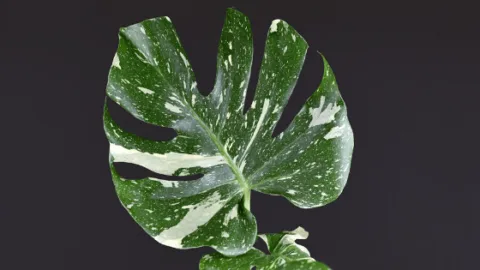The Monstera Thai Constellation is the Variegated Monstera that never loses its variegation. Its care is easy, but you must be careful with overwatering and root rot.
The Thai Constellation Monstera is a beautifully engineered Variegated Monstera Deliciosa grown from tissue culture in Thailand.
The initial plant that was used for cloning already contained the Phytophthora fungus. This is why most clones are much more prone to root rot than other Monstera types.
Monstera Thai Constellation Takeaways
| Species | Monstera Thai Constellation |
| Synonyms | Monstera deliciosa Thai Constellation |
| Family | Araceae |
| Genus | Monstera |
| Growth | Climbing, Vining |
| Height | 3 feet |
| Width | 2 feet |
| Soil | Requires a well-draining soil mix rich in organic matter. |
| Watering | Every 7-10 days |
| Light | Bright Indirect |
| Temperature | 65-85 °F (18-29 °C) |
| Humidity | 60-80% |
| Fertilizer | Fertilize monthly in spring and summer |
| Propagation | Stem Cuttings or Air Layering |
| Toxicity | Monstera Thai Constellation is toxic to humans, cats, and dogs. Contains calcium oxalate crystals. |
Monstera Thai Constellation Care
The Monstera Thai Constellations prefer soil with high organic matter. The best soil for Monstera Thai constellation contains bark, and perlite as drainage. An airy mix is essential. Water when the top 2 inches are almost dry. Do not overwater, ever. Provide humidity of 60% or more and temperatures between 64°F − 70°F (18 to 21 degrees Celsius). Fertilize once a month in Spring and Summer.
To read more about the Variegated Monstera, you can check out our article about The Elusive Variegated Monstera Deliciosa.
Monstera Thai Constellation is native to southern Mexico and Panama.
As the plant develops, the leaves take different structures.
This houseplant is gaining popularity, and under perfect indoor conditions, it grows up to 20 feet tall (6m), making it a signature statement plant for any indoor place.
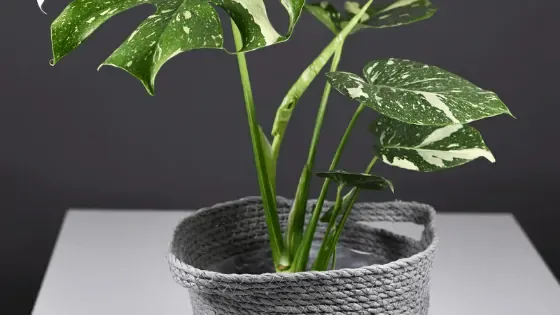
The variegation on the Monstera Thai Constellation is stable, differentiating it from the variegation on the Monstera Deliciosa Borsigiana.
It is an upward-climbing shrub currently in high demand among gardeners and indoor plant lovers worldwide.
The distinctive leaves have cream and green variegation with large holes, which can grow up to 3″ wide in size.
The leaves can sometimes grow up to 12″ in size (30.4cm).
The unique marble pattern on the plant leaves is caused due to a lack of chlorophyll; not surprisingly, this rare mutation increases the price of the plant.
The pattern resembles a starry constellation hence the name Monstera Thai Constellation.
If you are about to add one to your indoor plant collection, continue reading,
I have collected all the information to care for this beautiful tropical plant and have multiple specimens in my care.
Table of Contents
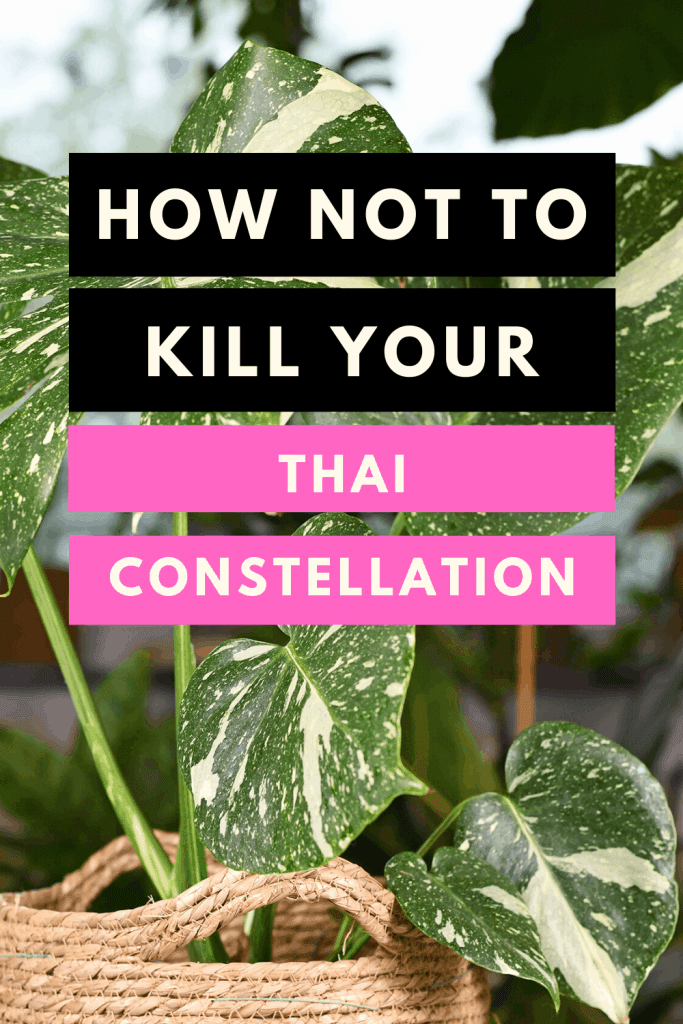
Thai Constellation Monstera Care Guide
Compared to other varieties of Monstera, the Monstera Thai Constellation is less drought tolerant and has a slower growth rate.
But this uniquely patterned plant is generally easy to care for.
Some of the Thai Constellation plants produce new leaves every month.
But the frequency of the growth depends on the care you provide to your plant.
From my experience, they can also grow very slowly, and it is not uncommon that these plants will do nothing in the first 3-6 months they arrive at your house.
Patience is a virtue, they say.
Let’s now look at the different aspects of Monstera Thai Constellation care.
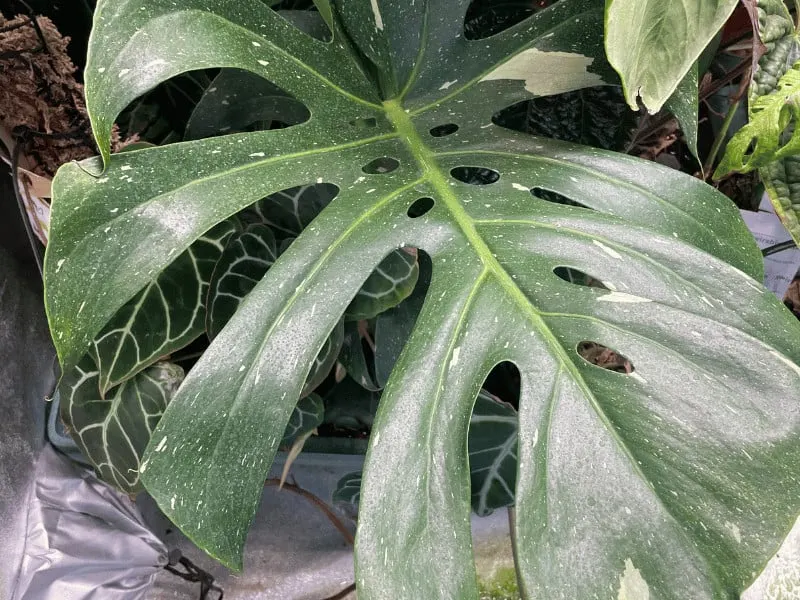
Thai Constellation Soil Mix
Monstera Thai Constellation loves moist soil with high organic matter and nutrients.
Choose a peat-based soil mix that is light and airy to reduce the chances of overwatering the plant, especially in cold months.
The potting mix should contain the right amount of bark and perlite to aid in draining.
This tropical plant needs soil with a pH of 5 to 7.5.
If the compost is excessively dry, the leaves start turning brown.
In short, the soil should be kept moist in the summer months and slightly dry in the winter months.
Monstera Thai Constellation Light Requirements
Choose a bright area or room with plenty of bright indirect light for the Monstera Thai Constellation.
But this plant should never be placed in direct sunlight as it will damage the leaves.
If the plant receives less light than required, the growth of the plant will slow down.
The yellow or creamy part of the leaves cannot absorb the sunlight; therefore, low light conditions are not preferred.
Else the plant has to struggle twice as hard for photosynthesis.
The sunlight given to the plant needs to be filtered; this is done by diffusing the light using sheer curtains or textured glass windows.
If there aren’t many options for good lighting in your house or apartment, use indoor fluorescent lights or artificial lights.
An hour or so of morning sun is good for the plant’s health.
Watering
I would also recommend aerating the plant’s soil before its initial watering.
It will help in moisture release and allow the soil to breathe.
The aerial roots of plants are sensitive to overwatering; avoid keeping the plant in soggy soil for long periods to prevent root damage.
Root rot is quite common on these plants, and I had to deal with this issue several times on multiple Monstera Thai Constellations I care for.
Somehow they seem to be more susceptible to root rot than the variegated Monstera deliciosa so really try to be on the safe side when watering.
If the top 2″ of the soil is dry, your plant needs water. Always check the moisture level before watering your Monstera plant.
You may use a moisture meter to track the moisture level more precisely.
Water the Thai Constellation regularly, once weekly, but decrease watering in colder months.
Most professional gardens recommend filtered water or rainwater; it’s more beneficial for plant health.
In the case of under-watering, the plant will have slower growth and will start wilting.
You might be overwatering if you notice water droplets or sweat on the leaves.
In winter, you should allow more time between waterings to ensure the soil has enough time to dry properly.
Humidity
Do not place the Monstera Thai Constellation near vents or drafts as the plant does not enjoy dry weather conditions.
In arid conditions, the plant might start dropping leaves.
As a tropical plant, Monstera Thai Constellation prefers humid weather—high humidity results in a faster growth rate.
If the indoor humidity is too low, the tip of the leaves will become brown and crispy. Increase the humidity by misting the leaves instead.
Keep the humidity at 60% or above for the best results.
Temperature
The perfect temperature for the Thai Constellation plant is between 64°F − 70°F (18 to 21 degrees Celsius).
The Monstera Thai Constellation is not frost-hardy.
Any temperature lower than 64°F (18 degrees Celsius) will slow down the growth of the plant, whereas temperatures lower than 50°F 10 degrees Celsius will eventually stop the growth.
Pruning
The Monstera Thai Constellation requires not a lot of pruning in general, which makes it a low-maintenance indoor plant.
Pruning is recommended to control the plant’s size and remove dead or damaged foliage.
If your Monstera plant has grown too big, you can prune the plant to manage growth.
If you repot the Monstera Thai Constellation plant in the same pot after refreshing the soil, you might also have to prune the underground roots.
This can be good practice if you cannot upgrade the pot to a bigger one.
For your safety, you should always wear gloves while pruning your plants.
Doing this will also reduce the risk of transferring unwanted pests or diseases to your Monstera plant or other plants.
Always sterilize your cleaning tools. You can do this by wiping them with isopropyl alcohol.
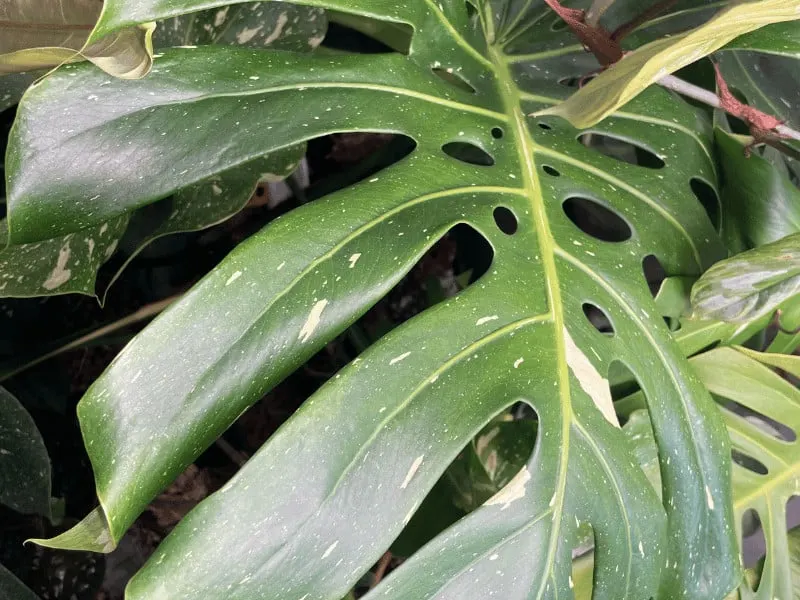
Monstera Thai Constellation Fertilizer
The best fertilizer for a Thai Constellation is a balanced fertilizer.
Monstera Thai Constellation is a slow-growing plant, but you can use an organic house plant fertilizer in the summer and spring seasons.
To encourage new growth during these two seasons, apply the fertilizer once every month.
I would recommend a slow-release fertilizer for the Thai Constellation; fertilize sparingly away from the base of the plant.
You can apply the fertilizer as slow-release pellets or as a liquid.
I would suggest liquid fertilizer as it will give you more control of the feeding and amount.
You do not need to feed the plant with fertilizers in the winter months.
Propagation
Thai constellation propagation can be done through cuttings.
Not all parts of the Thai Constellation will propagate. For example, leaves with no stem, aerial roots without stem, or stems without nodes and leaves cannot grow a new Monstera plant.
Use a high-quality rooting hormone to help the plant produce more roots in less time and protect it from fungal or bacterial infections.
No two leaves are the same on a Variegated Monstera Thai Constellation.
Similarly, each propagated plant is unique.
Since the variegated varieties are expensive compared to other houseplants, propagation is an easy way to expand your plant collection.
You need a pair of sharp scissors, a pot of soil or water. Three common methods of propagation are:
Propagation By Stem Cuttings
- Use a clean knife or pruning shears and cut a portion of your plant stem with at least one node and leaf, including aerial roots are optional.
- Including the leaves will increase the growth potential of the new plant, and nodes with grow new aerial roots.
- The time of the year is crucial because the cuttings will take longer to grow in winter as the plant is dormant.
- Now choose a growing medium for the cutting, and put it 1 or 2 inches deep in moist soil or water. If you use water, you can easily check the plant’s progress.
- I recommend using rain or distilled water to propagate in the water. Also, add some seaweed to the water to provide some nutrients for growth.
- Place the stem cuttings in a warm and bright location for fast sprouting.
- If you propagate a Thai Constellation in water, change the water regularly. Whereas in soil water, it regularly (once a week) keeps the soil moist.
- Transfer the plant to a suitable container when you notice new root growth and leaves.
- Fertilize the propagated Thai Constellation only when you notice new growth, typically taking 3 – 6 weeks.
Propagating by Separation
If you have a large Monstera plant, you can propagate it by separating it into two or more plants. This way, you can minimize the large Monstera Thai Constellation to a manageable size:
- Before separating, water the plant and allow the soil to dry.
- Now carefully remove the plant from the pot; you might need additional help if it is too large or has climbing support.
- Using a knife or scissors, cut and divide the roots between making two or more plants. Do this carefully without breaking any stems or leaves.
- Choose a pot 2-4 inches larger than the root ball and pot each plant in a clean pot with fresh soil.
- Place the propagated plant in a bright location and water the plant regularly.
- You can start fertilizing the plants after one month of planting them.
Propagation by Air Layering
In this method, you encourage the aerial roots to expand on the plant before taking the stem cuttings.
- Choose the stem you will use for cutting. Make a small cut at the node below this stem with a clean knife or shear.
- Wrap the cut and node with damp sphagnum moss using a plastic wrap or propagation bag and lock it with a string or tie.
- After every two or three days, remove the wrapping and spray the sphagnum moss with filtered water.
- After two months, you will notice new healthy and strong roots growing from the node. Take the stem cutting and plant it in a new pot.
Monstera Thai Constellation Growth Rate
Monstera Thai Constellation is a slower-growing indoor vine plant compared to the solid-colored varieties of Monstera.
The adult plant can take between one to two years for full development.
The growth of the Monstera Thai Constellations typically depends on sufficient light, water, and nutrients mostly.
The ideal condition for growth is bright indirect light and consistent watering. The plant can grow 1-2 feet taller every year.
Read our guide to select the right light level for your Monstera Thai Constellation.
Potting and Repotting Thai Constellation
The Thai Constellation needs to be repotted every two years.
Use a pot one size bigger than the previous one.
If you use a very large pot, the plant roots will drown.
Use an organic potting mix with the recommended fertilizer.
Repot your plant in the summer or spring season, as the plant is then strong enough to handle the risk of transplant shock.
Using the same pot will restrict the size of the plant; this should be done if you do not want the plant to take over or get any bigger. Follow these simple steps below to repot your plant:
- Remove the Thai Constellation plant from the pot and thoroughly inspect the root system.
- Fill half the container with a rich potting mix and water the soil to help it settle. Always use a container with drainage holes.
- Place the supporting structure to encourage vertical growth.
- Now place the Thai Constellation plant in the middle of the pot and backfill the pot with potting mix.
- Water the soil again and place the plant in a warm location with bright, filtered light.
Common problems with a Monstera Thai Constellation
Like any other houseplant, the Monstera Thai Constellation is vulnerable to pests and diseases.
Preventive measures for your houseplants are to inspect your new plant for any bugs and quarantine it for a few days before you put it where your other plants reside.
Below are some common pests and diseases that affect the Monstera Thai Constellation, including preventive treatments:
Root rot
When the leaves are yellowing or wilting, and the stems are dying, your Thai Constellation plant probably suffers from root rot.
Overwatering is the most common reason for root rot; in overwatered conditions, the roots cannot breathe and lack oxygen.
The roots affected by root rot are black and mushy.
Root rot can spread and easily damage healthy roots; therefore, inspect the plant roots regularly and prune the damaged roots immediately.
Sometimes a dormant fungus in the soil can also cause root rot. Repot the plant in fresh soil to encourage new growth.
Treating root rot as soon as possible is essential for plant survival.
Remove the Monstera Thai Constellation plant from the soil and wash the roots under running water.
Now use a clean and sharp pair of scissors to prune the damaged roots.
Dispose of the soil and disinfect the pot with a bleach solution. You can further reduce the risk of over-watering by improving drainage.
Mealybugs
They are white-colored bugs and are mostly found in new growth. They suck the sap from the leaves and stems of the Thai Constellation plant.
These pests are commonly located on the leaf joints or the veins of the leaves.
If the Thai Constellation is infested with mealybugs, the growth is stunted, the leaves are deformed, yellowing, and may start dropping.
Mealybugs can also come from contaminated soil, so always inspect your newly bought Monstera Thai Constellation plant for any bugs.
Separate the infected plant from other healthy plants to stop the spread of the bugs to houseplants.
Now clean the plant leaves and stems with rubbing alcohol to eliminate mealy bugs.
Inspect the underside of the leaves and joints for these tiny white bugs. If your plant is small, wash it with soap and water.
For larger plants, spray them with insecticidal soap.
To protect the plant from mealybugs, spray it with insecticidal soap regularly.
Alternatively, you can also use neem oil, an effective pest control product for houseplants.
Spider Mites
Spider mites are serious houseplant pests and are difficult to detect with the naked eye.
Inspect your plants for tiny, dusty webs under bright light. Blotches or patterns on the leaves are other indications of spider mites.
They thrive in warm conditions like those provided by the Monstera Thai Constellation.
These pests suck the cells from the plant and reduce photosynthesis resulting in yellow leaves.
Remove the infected part of the plant and dispose of it if possible.
Increase the humidity near the Monstera Thai Constellation to stop the growth of spider mites.
Disinfect your gardening or indoor houseplant tools after each use.
Thrips
They are small white insects that feed on the moisture in houseplants. Thrips cause discolored leaves, dehydration, and browning.
If one or two leaves of the Monstera Thai Constellation are infected with thrips, you can prune these leaves to get rid of thrips.
You can use neem oil spray, a natural insecticide, for more severe infections.
Spray the infected leaves with neem oil to remove the adult thrips and eggs.
Another option is to use diatomaceous earth on leaves, which kills bugs or insects.
If your plant can be easily moved, take it to the bathroom or outdoors to blast it off gently with water. This will remove any eggs or insects still sticking to the plant.
Soft scale
They are sap-sucking insects closely related to mealybugs or armored-scale insects.
Soft scales suck the liquid from the phloem cells of the plant.
You may notice yellowing leaves and premature falling if the plant is heavily infested. A clear, sticky substance known as honeydew is seen on the leaves.
Remove the branches that are heavily infested and dispose of them.
Rub alcohol-soaked cotton or neem-based leaf shine on the affected areas.
You can also use insecticidal soap, mix a few drops of washing liquid with vegetable oil and dilute in water.
Organic soaps or oils are considered more effective against the soft scale than any chemical treatment.
Salt buildup
The salt buildup is one of the common problems that cause yellow leaves and burned tips; it will also prevent the plant from soaking up the water properly.
Overfertilizing can create salt buildup; you should flush the soil with water every few months to remove any buildup.
If the pot is small enough, place it in a sink or bathtub and allow the water to run through it slowly.
Later allow the water to drain properly from the pot and place it back in its previous position.
If the plant is quite large to flush indoors. Take it outside and water it with a hose for about 5 minutes. After draining the excess water, bring the plant indoors.
How to Care for Monstera Thai Constellation
- Monstera Thai Constellation can grow quite tall when it is fully developed. Provide sturdy support such as stakes or moss sticks to support its aerial roots and encourage growth.
- You don’t have to cut the whole leaf if the tips turn brown. Just trim the brown part following the original shape of the leaf.
- Rotate your plant occasionally to ensure proper watering from all sides.
- You should dust the leaves of your plant frequently; else, the accumulated dust will impact the photosynthesis process.
- Regularly clean the leaves of the Thai Constellation with neem oil to prevent any bugs or insects.
- Monstera Deliciosa Thai Constellation has a deep root system; therefore, gardeners recommend a deep container instead of a shallow one for proper root growth.
Frequently Asked Questions About Thai Constellation
Why are the leaves on my Monstera Thai Constellation plant turning brown?
The top two reasons are that the plant receives too little light or has a salt buildup. Move your Thai Constellation plant to a location with better lighting conditions. It will help the plant in chlorophyll production. This variety is sensitive to salt buildup, don’t use tap water or let the water sit for a few hours before watering. This way, many minerals and chemicals evaporate from the water reducing the salt buildup.
How fast do Monstera Thai Constellation grow?
Monstera Thai Constellation are slow-growing plants. They grow about one leaf every 1-3 months. A period without growth for 6-12 months is also possible after repotting or rehoming this houseplant.
How often to Water Thai Constellation?
Water a Thai Constellation once a week.
Why is my Thai Constellation turning yellow?
The common reason for the yellowing of plants is overwatering. Observe your plants watering needs to avoid overwatering. Another reason could be the size of the pot. Your plant might be rootbound and needs a bigger pot for growth. If the roots are visible on the topsoil and twisting around the pot, the plant needs to be repotted.
Is the Monstera plant poisonous?
Yes, Monstera is poisonous. Always make sure you are keeping this plant away from children and pets. Sometimes the sap of the plant can irritate. Consumption can cause swelling, burning, or vomiting in pets.
The Last Thai Constellation
Variegated Monstera Thai Constellation enjoys a warm, humid climate, decent water, and gentle sunlight. With unique heart-shaped leaves and unique variegation, the Monstera Thai Constellation is the envy of many.

